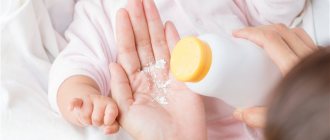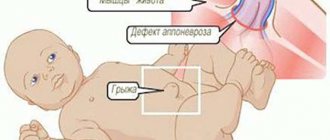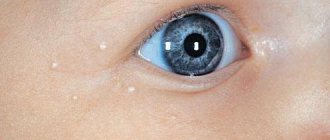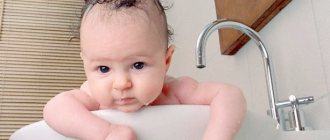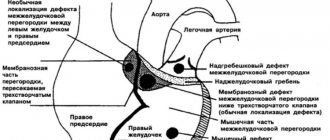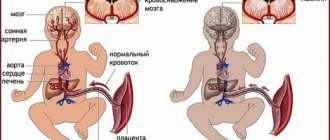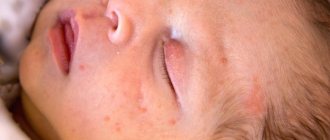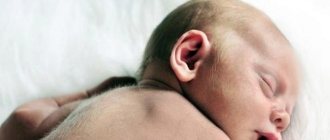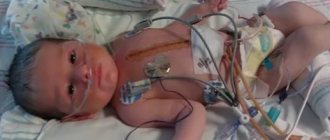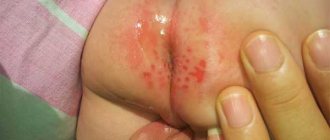What to do if a child’s earlobes crack?
My nephew's ears are wet and cracks have appeared near his earlobe.
He is one and a half years old. It happens that the cracks are even bloody. We treat it with baby cream, but it does not heal the wounds. Cracks appeared in winter, but were not observed in summer. Could this be a manifestation of diathesis or something serious? What could it be? This could be a food allergy, often starting when you were pregnant. It’s better to go to a good dermatologist and do not self-medicate, so that later this problem does not develop into a more complex form, even eczema. While this is a mild form, it may signal more serious problems.
Our pediatrician told us that peeling often occurs behind the ears in children. They lie around a lot, rubbing these places. We, too, when I was little, often peeled off. And even now it happens sometimes (although you’re already a year and a half old, it should have passed). We applied bepanthen. Give it a try. Or zinc ointment - it dries it out. In general, both of these remedies are harmless and are most often found in the medicine cabinet of young mothers. If it doesn’t help, then a pediatrician or a dermatologist.
I don’t want to scare you, but peeling behind the ears with the formation of weeping, non-healing wounds can be signs of a very unpleasant disease called scrofula. It’s just that, a long time ago, I was lying with my son in an infectious disease ward, and there in the next box there was a girl sick with scrofula. I remembered how her mother said that the first signs of this disease in the child began with weeping wounds behind the ears. I think that consulting a doctor in your case will not be superfluous.
The first step is to consult a doctor. But don’t shy away from traditional methods either. From time immemorial, scrofulous children were bathed in a decoction of the string. Or in a decoction of the second layer of linden bark - linden sapwood. Another simple and affordable remedy is to sprinkle dried ginger powder on the wounds, which is sold as a seasoning. Great for adults and children.
If they crack like crazy, then yes, see a doctor. Well, most often, the skin on the ears dries out if the child eats a lot of sweets ("cakes" can also form behind the ears). Therefore, you need to stop giving your child a lot of sweets, and think about his health. Apply baby cream, then everything will go away quickly.
Olyushkin, both my children had this problem at one time, and if with the first we spent a long time running to the doctors, then with the second we quickly solved the problem (experience is a great thing!): diet (do not burden the gastrointestinal tract), drink plenty of clean water, after When bathing, rinse the irritated areas with a solution of soda and salt (half a teaspoon of both per glass of warm boiled water), do not wipe, but blot and immediately smear with zinc ointment (it costs a penny at the pharmacy) and you can also apply a rich baby cream directly on top of the zinc ointment . Give it a try, I hope it helps your nephew as effectively as it did my kids!
Your advice is correct, they help in most cases, but it’s still better to see a pediatrician first so that he can make an accurate diagnosis. This is further aggravated by the fact that the appearance of various rashes on a child’s skin can lead to traumatization due to the special sensitivity of the skin, as well as the body’s reaction to various irritants. In this case, cracks can appear behind the ears not only in small children, but also in adult children.
This phenomenon is far from rare and occurs quite often in pediatrics. Moreover, there can be many reasons, so you need a doctor to establish them. He will conduct a visual examination and refer you for additional diagnostics, if necessary, to establish an accurate diagnosis and the necessary treatment.
Cracks can be caused by an allergic reaction, atopic dermatitis or exudative diathesis, eczema, or fungal infection. It must be said that they do not arise out of nowhere - they are provoked by a number of factors.
One of them is the aggressive influence of the environment. Temperature changes, dry air, hard water. In this case, the task of parents is to minimize the negative impact of such factors on the child’s body.
The air temperature in the room should not exceed 20 degrees, and the humidity should be below 70%. In addition, it is necessary to constantly ventilate and do wet cleaning. The child should not overheat or become hypothermic both at home and outside. In addition, after bathing, it is better to always treat the child’s skin with special creams, paying attention to the area behind the ears.
You should not discount allergies, which manifest themselves as various rashes on the skin. Moreover, if one of the parents has such a problem, then it can be inherited by the child.
The skin behind the ears of a child cracks and peels: causes of formation in infants
Crusts behind the ears of a child are not uncommon. The symptom most often becomes noticeable during hygiene procedures. Such peeling usually has an unpleasant odor, which causes inexperienced parents serious concern about the health of the baby. In addition to being an aesthetic problem, the crusts cause discomfort, causing severe itching.
As a result, the baby begins to be capricious and cry, sleep is disturbed, and appetite disappears. In such cases, it is necessary to identify the cause that caused the problem and, by eliminating it, get rid of the symptom. The article will discuss why the skin behind the ears cracks in a small child, how to eliminate the symptom, and what are the measures to prevent this problem.
Baby hygiene - effective prevention of skin diseases
Consequences of poor child hygiene
Crusts and peeling behind the ears of a baby are often the result of poor hygiene of the baby.
When a baby drinks milk (regardless of the type of feeding: breast or artificial), some liquid gets behind the ears. In addition, dirt and sweat accumulate in these areas.
All these components mix with each other, and the process of rotting begins, which causes an unpleasant odor, itching and irritation.
Causes of crusts and peeling
Milk crusts in a child
The main provoking factors that can lead to the formation of scales and cracks behind the ears in a child include:
- Neglect of hygiene rules.
- Staphylococcus. If hygiene standards are observed, but the problem does not disappear, the help of a pediatrician will be required. The bacterium is detected using a special analysis - microflora culture. Staphylococcus is an opportunistic microorganism that is present in most people. If the body's protective functions work normally, and hygiene procedures are carried out regularly, correctly and in a timely manner, the bacterium does not cause harm. In the opposite situation, its active reproduction and spread occurs.
Important! If, in addition to crusts and peeling, the baby has a fever, you should immediately contact a specialist.
Redness and pus formation are often observed around the crusts. With such symptoms, it is forbidden to take a bath or apply heat to the source of inflammation. Treatment is carried out using antibacterial agents, the areas behind the ears are treated with antiseptic ointments.
- Allergic reaction. Often a newborn's ears become flaky due to certain types of allergies. Most often, a negative reaction is associated with the consumption of certain products. The most common allergens are:
- Chocolate, honey;
- Citrus;
- Other fruits (grapes, persimmons, bananas);
- Nuts;
- Melon, tomatoes, eggplants, carrots, beets;
- Milk and dairy products;
- Cocoa, coffee, tea;
- Eggs;
- Meat;
- Seafood;
- Mushrooms.
If the baby is on IV, it is better to switch to another milk formula, and also exclude complementary foods from the diet. If negative symptoms persist, other allergens may be the cause of the appearance of crusts:
- Various baby care products (ointments, powders, shampoos);
- Washing powder and other household chemicals;
- Dust;
- Animal wool;
- Plant pollen;
- Poplar fluff;
- Mom's new cosmetics;
- Toys.
Important! If a negative reaction in a child still persists even after the suspected allergens have been excluded, it is worth visiting a doctor.
- Seborrheic dermatitis. The symptom in the form of crusts behind the ears (as well as on the neck, head) occurs due to excessive secretion of sebum, as a result of which the layer of the epidermis separates and crusts form. Dermatitis can be caused by allergic reactions, endocrine disruptions in a woman during pregnancy, and the use of certain medications. A mild form of pathology is not accompanied by dangerous symptoms and is limited only to aesthetic problems in the form of peeling skin. A severe form is characterized by the spread of a negative sign to other parts of the body. The child is not only bothered by itching, his general health worsens, and his sleep is disturbed. In the first case, the doctor prescribes a diet and external remedies for seborrhea. In the second case, the doctor prescribes ointments containing steroid hormones, antibiotics, and drugs to strengthen the body.
- Scrofula. This is what people call a type of atopic dermatitis. The disease mainly affects children from the first months of life to 10 years. When the flaky particles are removed, you may notice fresh, pink skin that looks like it has been burned. Scrofula can be caused by allergic reactions (for example, to food). Dermatitis also occurs against the background of decreased immune defense, due to a lack of vitamin D or non-compliance with hygiene and sanitary standards.
Interesting. As practice shows, scrofula often occurs in “late” babies.
Dermatitis can be caused by such serious pathologies as syphilis, tuberculosis, and malignant tumors that the child’s mother suffered from. It has been noticed that scrofula often affects children conceived by parents who abused alcohol.
At first, the disease can be confused with ordinary diaper rash. Then the skin begins to peel off, forming a golden crust with cracks (which gives the name to dermatitis). If left untreated, such formations will spread to other areas of the skin.
A crust behind a child's ear
Symptoms of crusts and peeling
Irritation on a child’s bottom - what to do if the buttocks are red
If a crust has formed behind the ears of a newborn baby, the symptoms may be as follows:
- Unpleasant odor emanating from the site of inflammation;
- Itching;
- Redness;
- Restless behavior;
- Sleep disturbance;
- After removing the particles, there are no ulcers or wounds;
- In some cases, an increase in temperature.
A crust behind the ear as a sign of scrofula
Why are crusts and peeling dangerous?
Vomiting water in a child under 1 year of age - what to do when he feels sick
The harm from the appearance of crusts behind the ears in a child lies mainly in the reason that contributed to this. If a serious pathology acts as a provoking factor, then the baby requires adequate treatment.
How to get rid of crusts
Since most often crusts behind a child’s ears are formed due to non-compliance with hygiene rules, appropriate procedures will help eliminate the unpleasant symptom. So, to save your baby from the problem, you need to follow these instructions:
- Immerse the baby almost completely in water, leaving only the face on the surface. Thanks to this, the crusts soften and are easier to separate.
- After the procedure, wipe the skin behind the ears dry and remove the crusts using a cotton swab or disk.
On a note. If the crust that appears behind the baby's ear is difficult to remove, it must be softened with baby cream or special oil purchased at the pharmacy. The crust should soak for 2-3 minutes, then it can be carefully removed.
- Treat the area with sea buckthorn oil - the product will help relieve irritation and soothe the skin.
- After a couple of minutes, wipe the areas with a clean, dry cloth (which will absorb any remaining oil).
- Moisturize the skin with cream (otherwise the overdried dermis may crack).
- If the room temperature is too high, it is better to apply powder to the skin.
- Your child's ears need to be cleaned regularly.
Causes of cracks behind the ears
The cause of cracks behind the ears in a child may be too hard water.
Often parents are faced with the problem of cracks behind their child’s ears. The main factors that provoke their appearance include:
- Sudden changes in ambient temperature and insufficient humidity.
- Swimming in hard water.
- Genetic predisposition to allergic reactions.
- A diet that includes frequent consumption of a variety of sweets and rich foods. If a woman during pregnancy or breastfeeding is addicted to allergenic foods, this can negatively affect the baby.
- Weakened immune system of the child's body.
- Functional disruptions of the digestive system and metabolism.
- Mechanical damage in the area behind the ear, accompanied by the penetration of a fungal infection.
- Hygiene products and synthetic detergents, the composition of which can cause an allergic reaction (shampoo, soap, gel, powder).
- A baby's delicate skin and excess weight can cause diaper rash behind the ears due to constant rubbing.
Such negative factors can affect the occurrence of the following diseases characterized by the presence of this symptom:
- exudative diathesis;
- scrofula;
- eczema;
- dermatitis;
- otomycosis.
Symptoms of skin disease
- the appearance of red diaper rash behind the ears and under the hair, after some time they become yellow, but the hair does not fall out or break (we recommend reading: reasons why hair falls out in a 6-year-old child);
- as the disease develops, the area of the lesion increases, it spreads to the neck, face, arms and legs;
- the skin becomes cracked, becomes wet and peels (we recommend reading: what to do if the skin on the head of a 5-year-old child is peeling?);
- severe itching;
- peeling of the earlobes;
- bloating, digestive system disorders;
- inflammation of the cervical lymph nodes (we recommend reading: what causes inflammation of the lymph nodes in a child’s neck?);
- joint pain, swelling;
- redness of the eyes.
If the crack gets wet
When a child begins to get wet behind the ear, this is a clear symptom of the presence of a pathological process in the body of a dermatological nature.
Weeping diathesis
This disease is often diagnosed in infants and is accompanied by the following symptoms:
- scaly crusts of yellow-gray color;
- rash;
- redness of the skin behind the ears, followed after a few days by the appearance of blisters filled with liquid;
- constant itching and burning;
- pain in the area of the burst blister.
Weeping diathesis occurs in a child due to an allergic reaction to food or mother’s breast milk. In this case, parents urgently need to identify the allergen and eliminate it from the child’s life.
Important: Unconsciously scratching the wet area behind the ear can cause infection in this area.
Due to contact of the child's parotid area with an irritant contained in a hygienic detergent, the temples of glasses or the metal of earrings, an allergic reaction on the skin may occur. Not least important in the occurrence of this pathology is the genetic factor. Children of parents with allergies are often more predisposed to allergies of various forms. Children are diagnosed with a chronic pathology such as gneiss.
In this case, the skin behind the ear is susceptible to the following symptoms:
- dryness;
- burning and itching;
- redness due to inflammation;
- the lobe and area behind the ears are peeling;
- if spots become wet behind the ear, this indicates an acute course of the disease. Swelling and crusts appear;
- cracks.
As in the previous case, it is necessary to remove all objects in contact with the affected area and consult a dermatologist about medications to eliminate the symptoms that appear.
This non-infectious disease manifests itself in children under 10 years of age and is considered the initial stage of atopic dermatitis. Basically, the affected area is considered to be the area behind the ears, but if the process is advanced, scrofula can also appear on other areas of the skin (forehead, cheeks). The main symptoms are:
- the formation of whitish-gray spots behind the ears, gradually spreading to a large area of the head;
- unbearable itching;
- peeling;
- rash and the appearance of lichen;
- enlarged lymph nodes;
- the spots are covered with golden-colored crusts. When they peel off, a wet, reddened skin remains, so the child’s earlobe may become wet.
Why does an adult get wet behind the ears?
For successful treatment, it is necessary to determine the factors that provoke the appearance of discharge behind the ears. Only a doctor can make a diagnosis. In adults, the following reasons contribute to weeping behind the ears:
- allergic reaction;
- scrofula;
- fungus in the body;
- stress;
- frostbite;
- psoriasis;
- eczema behind the ears (tinea versicolor);
- lack of personal hygiene;
- lack of vitamins and minerals;
- disruptions in the hormonal system;
- decreased immunity;
- otitis media (ear inflammation);
- dermatitis;
- passive lifestyle.
Scrofula in adulthood
At the initial stage of the disease, golden crusts appear on the scalp. When they fall off, red spots are observed. It is possible that a secondary infection may occur. Then deep wounds form at the site of damage. The tuberculosis form is accompanied by a purulent runny nose and inflammation of the lymph nodes. Body temperature rises, the patient experiences general malaise.
The main cause of scrofula in adults is the presence of Koch's bacillus in the blood. In this case, the active form of tuberculosis does not develop, there is no serious illness. Bacterial infection is treated with antibiotics; in addition, zinc ointment, vitamins and anti-allergenic drugs are used. After 30 days, the presence of the rod in the body is checked again. If necessary, treatment is continued.
Allergy
Allergy sufferers often notice weeping sores behind their ears. This develops due to exposure to irritating substances and unfavorable environmental factors. Wetting occurs due to wearing jewelry or using headphones. A common reason is the use of cosmetics that cause allergies.
Article on the topic: Musculocutaneous nerve: anatomy, topography, diseases - neuralgia, neuropathy
This condition occurs in people with reduced immunity. In some cases, weeping appears due to nervous tension. Characteristic blistering rashes are accompanied by itching and redness. In rare cases, the following are observed:
- difficulty breathing;
- cough;
- headache;
- temperature increase.
Dermatitis
Inflammation of the skin due to the action of biological, chemical, and physical factors is called dermatitis. Possible causes are neglect of personal hygiene or mechanical damage to the skin. There are several forms of pathology - from harmless flaking of the skin to serious dermatological problems.
With dermatitis, the skin in the ears peels off and itching appears. The affected areas swell and serous exudate is released. The chronic form is accompanied by the formation of warts. The course of the disease is influenced by the state of the immune system and the presence of chronic abnormalities. Intoxication of the body or work in hazardous industries provokes the occurrence of dermatitis.
Treatment includes the use of ointments and creams, and in rare cases, the use of antimicrobial drugs. It is recommended to follow a diet, give up sweet, fatty, spicy, salty foods. This helps normalize the functioning of the gastrointestinal tract.
Diagnostics
At the appointment, the treating specialist will conduct an examination and clarify with the parents the possibility of a hereditary factor. To understand the cause of cracks behind the child’s ear and make the correct diagnosis, the doctor will prescribe certain examinations:
- a general blood test to determine the presence of inflammation;
- bacterial culture of ear secretions. It is taken if otitis is suspected in order to clarify the type of pathogenic microorganism and the necessary antibiotic to combat it;
- allergen detection tests;
- a smear from the skin behind the ear to identify the fungal parasite and, if necessary, its sensitivity to drugs;
- immunogram.
Based on the research results, the doctor selects the necessary medications for therapy.
How to treat
After determining the cause of the crack behind the child’s ears, the following types of medications are prescribed:
- antihistamines in the form of tablets (Suprastin, Loratodin) or drops (Tavegil, Parlazin) to relieve itching;
- ointments with a drying effect (zinc ointment) will help get rid of weeping lesions;
- after water procedures, it is recommended to treat the area behind the ears with Bepanten or creams with depanthenol for a healing effect;
- Corticosteroid ointments can be used to treat severe cases. From 6 months, children are recommended to apply Celestoderm B;
- if an infectious infection occurs, then antibiotics are added to therapy. At the same time, it is important for the child to combine such treatment with taking medications to restore intestinal microflora (Linex, Bifiform);
- immunomodulators and vitamins;
- Weeping cracks should be treated with Levomekol;
- crusts are removed by preliminary softening with prednisolone ointment;
- fungal infection is treated with appropriate medications.
Physiotherapy through the use of ultraviolet rays has a wound-healing and anti-inflammatory effect.
As folk remedies for scrofula, you can use lotions made from string and chamomile, and for weeping diathesis, a bath with oak bark is an excellent remedy.
It is important during treatment to carefully select food products and maintain ear hygiene.
Prevention
To prevent cracks behind the ears in a child and the possible consequences of this symptom, follow these rules:
- pay attention to any allergic manifestations after your child consumes a new product;
- walk in hot weather for no more than 1 hour in the shade;
- carry out timely wet cleaning of the room and ventilation;
- strengthen the child's immune system;
- carry out careful hygiene in the area behind the ears;
- select anti-allergenic detergents and hygiene products;
- moisturize the skin with special baby creams;
- carry out timely treatment of the parotid area in the presence of scratches, cuts and other microtraumas;
- During pregnancy and lactation, monitor your diet and do not overuse allergenic foods.
Allergic reactions and various skin dermatitis are not uncommon in childhood, so you need to carefully monitor your baby's skin. If you know that your child is predisposed to allergies, then try to take all preventive measures to avoid dangerous complications.
Symptoms
To establish the cause of changes in the skin behind the ears, you should first pay attention to the symptoms. After all, every disease has certain signs by which one can draw a conclusion about the existing diagnosis. First, the doctor interviews the parents or the child who is already quite old. This is necessary to identify provoking factors, information about the onset of the disease and its course, as well as subjective signs (complaints). A physical examination is then performed with local and general examination.
Diaper rash
Overweight babies often have diaper rash. They appear in areas of the skin subject to constant friction, where there is increased humidity, including behind the ears. At first there is simply redness, then small cracks appear. In this place, weeping develops, crusts form, and later an infection (pustules) may develop. The baby becomes restless because it brings him discomfort.
Exudative diathesis
Exudative diathesis is understood as a pathologically altered reaction of the child’s body to unfavorable environmental factors: food, microbes, chemicals, medications. This is manifested by an increased tendency to allergic or inflammatory damage to the skin and mucous membranes. Symptoms of diathesis are usually caused by sensitization to food products (cow's milk, eggs, citrus fruits, strawberries, chocolate, etc.). In the area of the scalp, on the cheeks, behind the ears, first redness appears, then itchy blisters with clear liquid. Over time, they burst, and in their place yellowish crusts with small cracks and peeling form. Due to the desquamation of the surface layer of the epidermis, the tongue becomes “geographical”. And various spots and papules may appear on the body.
The clinical picture in children with exudative diathesis often includes disorders of other organs and systems:
- Stool instability (alternating constipation and diarrhea).
- Poor weight gain.
- Frequent colds.
- Anemia.
- Rickets.
Therefore, even such a symptom as a rash on the cheeks or behind the ears requires careful attention. You should not think that this will go away on its own - you need to see a doctor for an examination before the situation goes even further.
Many young children suffer from exudative diathesis. But in addition to cracks behind the ears, it can have much more unpleasant consequences for the body.
Dermatitis and eczema
It should be noted that skin lesions are often inflammatory in nature. Infants and adolescents may experience what is called seborrheic dermatitis. It develops on the scalp, eyebrows, behind the ear and in the external auditory canal. Dry seborrhea is accompanied by skin hyperemia, the formation of scales and cracks. Sometimes papules form, merging with each other. The skin thickens, the child feels itchy and tries to scratch the area. When the external auditory canal is affected, a feeling of fullness in the ear may be noticed.
Microbial eczema is characterized by the appearance of blisters, which, after opening, form a weeping surface. The cracks are covered with yellowish-gray crusts. In the future, otitis externa may develop with corresponding symptoms: itching and burning in the ear, discharge from the ear canal, and hearing loss. Eczema from an acute form often becomes chronic.
Fungal infection
The appearance of cracks behind the ears in a child can also be associated with a fungal infection. It is in the nature of dermatitis or otomycosis. The latter is caused by the spread of microbial inflammation from the parotid region to the ear canal. Then you should expect the following symptoms:
- Itching and pain in the ear.
- Noise and feeling of congestion.
- Discharge from the ear.
- Skin redness.
The nature of the discharge is determined by the type of fungus. When examined in the external auditory canal, caseous masses of brown or black color, similar to blotting paper (in case of mold infection), yellowish crusts with cheesy layers or a white film (in case of candidiasis), may be detected. The spread of the process to the tympanic cavity leads to the appearance of otitis media. Then the clinical symptoms will become more pronounced.
Fungal skin infections in young children are not such a rare phenomenon, given the imperfection of the baby’s immune processes.
What it is?
Scrofula is a type of exudative diathesis and a disease of tuberculosis origin. The disease was described back in the 12th century. At that time it was considered mortally dangerous, and the treatment was, to put it mildly, unconventional - the patient was asked to venerate Catholic shrines. Around the same time, rulers from the French Capetian royal dynasty treated this disease by laying hands on the patient. At the same time, they said that the touch of the king gives God the opportunity to heal.
In this mysterious way, scrofula was treated en masse until the 19th century, and, apparently, contrary to logic, very successfully. Then doctors and scientists became interested in the strange disease and called it “scrofulosis.” The basis was taken from the Latin word “scrofa”, which means “boar”, “boar”, “wild pig”.
The name, of course, is crude, but quite accurate, because the face of the sick person already at the very initial stage began to resemble the snout of a boar due to the enlargement of the lymph nodes under the jaw and on the neck. Studying the causes of the disease, doctors came to the conclusion that the disease is caused by mycobacterium tuberculosis, which is directly related to the causative agents of the most basic types of tuberculosis. Thus, scrofula was included in this family and is sometimes called tuberculosis of the lymph nodes.
There is a popular myth that scrofula can lead to tuberculosis. This is not entirely true, since it is already a form of this disease, but it is more similar to the symptoms of exudative diathesis. That is why scrofula is considered the initial stage of this skin disease.
In fact, the situation with scrofula is quite paradoxical - behind one name, by and large, lie two completely different diseases, one of which is undoubtedly related to tuberculosis, and the second is a common dermatological-allergic one.
Symptoms
Both types of scrofula require treatment. The therapy will just be different. It will not be difficult to determine what kind of scrofula a child has, because the symptoms are very different from each other:
- From time to time, cracks appear in the scabs, from which serous fluid, sometimes mixed with blood, is released. Crusts can peel off without any discharge. In this case, completely smooth pink skin is visible under the crust. Quite often, such scabs behind the ears are accompanied by the appearance of formations similar in appearance on the scalp.
- Additional symptoms may include nasal discharge due to allergic rhinitis, discharge from the ears, allergic conjunctivitis, and swollen lymph nodes. Large folds on the child’s body become inflamed, and so-called diaper rash appears in them. Sometimes a cough and allergic swelling of the larynx are added.
- Scrofulosis manifests itself differently . At the initial stage, a small nodule will appear behind the ear or a little lower, closer to the neck. It gradually increases in size, softens, and one day bursts, releasing purulent and bloody contents. An ulcer or fistula forms. Other signs are added to this unpleasant picture: the child’s skin turns pale, his temperature rises, he sweats a lot and completely refuses to eat, and gets tired quickly.
- With scrofula of an allergic skin nature in a child, most often in infants aged 3 months or older, pockets of dry skin appear behind the ears, which are quite itchy. Quite quickly, scabs form on the affected areas, which are called “scrofulous crusts.” They are white or whitish-yellow in color, sometimes mixed with gray.
Features of treatment for children of different ages
As a rule, therapy for this disease does not depend on the patient’s age. If you suspect scrofula or diathesis, the skin is dry, cracking, or wet wounds appear behind the ears, you should contact your pediatrician as soon as possible (see also: dry skin on the legs and arms of a child). He will refer you for consultation to a pediatric dermatologist and allergist.
Experts will determine the cause of the sores and cracks. A special diet will be developed.
The next stage is the prescription of medications to relieve itching and remove crusts. If left untreated, a secondary infection may develop due to constant trauma to the skin when scratching; the wound behind the ears rots and enlarges. With timely treatment, scrofula can be cured in a short time.
It is important to strengthen the child's immunity. The defenses of a healthy baby’s body are able to cope with scrofula on their own.
Drug therapy
- Ointments. For the treatment of scrofula, Sudocrem, Tsindol, zinc ointment, Topicrem, Drapolene are used. They dry the wet crusts well, which then come off easily. Typically, these products are applied 2-4 times a day to clean skin, without washing off for several hours.
- To moisturize the skin with cracks and dryness, Bepanten is used.
- Cauterization with Fukortsin. This is a crimson-colored drug that effectively disinfects and cauterizes disease-affected skin. The child may complain of a burning sensation in the areas treated with Fukortsin. It is used if there is no improvement after 3-4 days of treatment with ointments.
- Enterosgel and other sorbents are used to remove toxins and cleanse the body. They also remove allergens.
Hygiene procedures
When scrofula does not cause symptoms other than crusts on the scalp and does not progress, it may not be treated. In this case, they get by by simply combing out the scab, that is, the crusts. Before this, the skin is generously lubricated with nourishing baby cream or Vaseline oil, and they are combed out with a regular comb. When removing crusts from a child under one year old, you need to be careful not to damage the fontanel.
When drug therapy is carried out, before using ointments it is important to thoroughly clean the skin and carry out other hygiene procedures. It is useful to take antiseptic baths with herbal decoctions.
Special diet
Strong allergens must be excluded from the diet of a child or nursing mother: candy, chocolate, citrus fruits, nuts, milk, etc. For scrofula, a food diary is kept, where parents write down everything that their child ate. This will allow you to track which products the reaction occurs to. You are allowed to eat low-fat broths and meat, hypoallergenic vegetables and fruits, and water-based porridge. Subsequently, other foods are gradually and carefully introduced.
Newborns and bottle-fed infants must be given only adapted formulas. It is unacceptable to feed your child goat or cow milk, as it causes very severe allergies.
Folk remedies
Traditional medicine offers an extensive list of recipes against scrofula. Before using them, you should consult your doctor.
Due to its effectiveness, baths with chamomile decoction are in great demand in the treatment of scrofula.
For scrofula in a child, baths with:
- chamomile decoction;
- oak bark;
- walnut leaves;
- decoction of currant leaves;
- tea tree essential oil.
An infusion of string is used internally and externally. It dries the skin perfectly and has an antiseptic effect.
Diagnostics
A pediatrician, a dermatologist, or an allergist can figure out what kind of scrofula happened. A general blood and urine test must be taken from the child, and an immunological blood test is additionally done to determine whether an allergic reaction has occurred. If it is confirmed, then the allergist conducts diagnostic tests for allergies to determine what exactly the child has such an inadequate reaction to. Without this, treatment will be ineffective.
Eczema-like spots behind the ears and on the neck with scrofulosis require a completely different approach from diagnosticians. The child is given a swab from the throat, as well as a sample of discharge from the skin to detect mycobacterium tuberculosis. If the diagnosis is confirmed, an ultrasound of the lymph nodes is performed to determine the extent and “geography” of the lesions.
Treatment for scrofula behind the ears will depend on what kind of scrofula is detected.
Exudative diathesis
First of all, you will need to eliminate contact with the allergen. If it is installed, then this will be easier. But quite often allergy tests do not show a positive reaction to the most common allergens, and then the cause is considered idiopathic. In this case, parents are advised to eliminate all possible allergens in the house where the baby lives. Hide away or throw away household chemicals; cleaning will have to be done without products containing chlorine.
The child's bed linen will need to be replaced with linen made from natural fabrics without patterns or textile dyes. The same requirement applies to underwear, pajamas, and clothing. You will need to wash children's clothes and bedding exclusively with children's hypoallergenic washing powders, and be sure to rinse with pre-boiled, chlorine-free water.
You will have to escort your pets out of the apartment; they quite often cause an allergic reaction in children, and also remove all objects that can accumulate ordinary house dust - carpets, soft toys. The child should not sweat, since sweating only intensifies the manifestations of scrofula.
Therefore, the baby should be dressed lightly, not wrapped up, so that the space behind the ears and head do not sweat. The air temperature in the apartment should not exceed 20 degrees.
